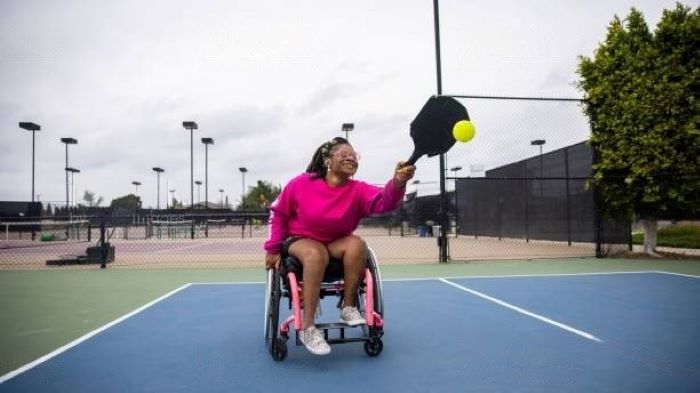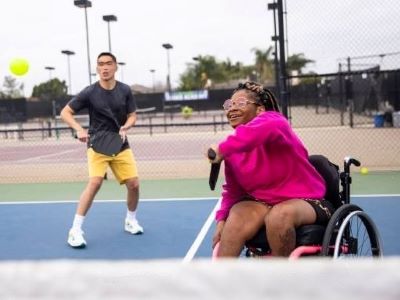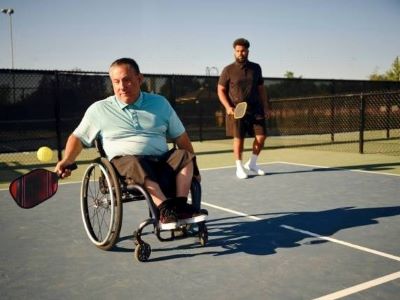Have you ever wondered if people in wheelchairs can play pickleball? Here we have covered the fact that people can play pickleball in a wheelchair. Players competing in wheelchairs must follow slightly different rules when playing pickleball.

By adopting these pickleball rules, the court size is increased, the ball can bounce twice on either side of the court before being returned, and the non-volley zone is slightly altered.
So, let’s dive in!
Rules of Wheelchair Pickleball
Wheelchair pickleball (Adaptive Pickleball) is a variation of pickleball where one or more players on the court are in a wheelchair. Wheelchair pickleball has mostly the same rules as standing pickleball, with a few exceptions. Here is a summary of the rules of wheelchair pickleball:

- Any contact between the wheelchair and the ball constitutes a fault.
- The player using a wheelchair can allow the ball to bounce twice before returning it. The second bounce can be anywhere on or off the court.
- The player using a wheelchair must serve underhand, and the paddle must contact the ball below the waist. The rear wheels of the wheelchair must be behind the baseline and not touch the court on or inside the baseline or outside the imaginary extensions of the sideline or centerline at the moment of contact.
- The player using a wheelchair can volley the ball (hit it in the air) outside of the non-volley zone (also known as the kitchen). The front wheels of the wheelchair can touch the non-volley zone during a volley, but not the rear wheels. If the rear wheels touch the non-volley zone, the player using a wheelchair cannot volley until both rear wheels are outside the non-volley zone.
- In this game, a player must win by two points to win. Singles and doubles games are available, and wheelchair users may play against or with standing players.
- The recommended playing area by USAPA for wheelchair pickleball is 74 feet long by 44 feet wide, and the standard court size for wheelchair pickleball is 80 feet long by 50 feet wide.
Note: You can check the rules for wheelchair pickleball on their official sites: USAPA and Adaptive Pickleball.
Difference Between Wheelchair Pickleball and Standing Pickleball
Wheelchair pickleball has mostly the same rules as standing pickleball, with a few exceptions to accommodate the mobility challenges of wheelchair users. Some of the main differences are:

| Difference Between Wheelchair Pickleball and Standing Pickleball | ||
| Rules | Wheelchair Pickleball | Standing Pickleball |
| Court Size | It’s recommended playing area is 74 feet by 44 feet, which is larger than the standard court size. | It has a standard court size of 44 feet by 20 feet. |
| Double-Bounce Rule | It allows the player using a wheelchair to hit the ball after two bounces. The second bounce can be anywhere on or off the court. | It requires the player to hit the ball after one bounce. The bounce must be in-bounds. |
| Non-Volley Zone | Allows the player using a wheelchair to touch the non-volley zone with the front wheels during a volley, but not the rear wheels. | Does not allow the players to touch the non-volley zone with any part of the body or paddle during a volley. If how they touch the NVZ line, it is considered “fault.” |
| Scoring | It has the same scoring system as the standard game. | It has the same scoring system as the standard game. |
Court Size
The dimensions of the pickleball court are the same for both wheelchair and standing pickleball (44 feet long by 20 feet wide), but the recommended total playing area for wheelchair pickleball is larger (74 feet long by 44 feet wide) to allow more room for maneuvering around the court.
Double-Bounce Rule
In standing pickleball, players must return the ball after one bounce on their side of the court; otherwise, it is a fault. In wheelchair pickleball, players can return the ball after two bounces on their side of the court, and the second bounce can be anywhere inside or outside the court.
Non-Volley Zone
In standing pickleball, players cannot volley (hit the ball in the air) if any part of their body or paddle touches the non-volley zone (the area 7 feet from the net on both sides of the court). In wheelchair pickleball, players can volley if their front (smaller) wheels touch the non-volley zone but not if their rear wheels touch it.
Scoring
The scoring system is similar for wheelchair and standing pickleball. A game is played to 11 points, and a team must win by 2 points. Only the serving team can score points. The serve alternates between teammates until they lose a rally, then it goes to the other team.
Wheelchair pickleball is a fun and inclusive sport that anyone can enjoy, regardless of their physical abilities. Enjoy yourself, stay active, and socialize!
FAQs
Wheelchair Pickleball is a modified version of the famous court sport, pickleball. It is designed to allow wheelchair users to play pickleball on the court using adapted wheelchairs and rules that accommodate their mobility limitations.
Para pickleball is a version of the sport designed to be played by individuals with physical disabilities such as mobility issues or visual impairments. It uses special techniques and equipment to accommodate the different abilities of each player, allowing them equal access to playing the game.
Yes, pickleball can be played in a wheelchair. Players can join pickleball tournaments around the world that are specifically for players in wheelchairs.
Yes, disabled people can play pickleball. Depending on the disability, minor adjustments may need to be made to the court or the rules for a person with disabilities to participate comfortably. Additionally, several adaptive programs and leagues are specifically designed for players of all abilities.
Wrap Up!
Wheelchair Pickleball is the perfect sport for players of all abilities and ages to enjoy. It provides an inclusive way for wheelchair users to enjoy a sport and collaborate with friends and peers.
By understanding the game’s rules, learning more about the differences between it and standing pickleball, and applying essential safety tips, you can prepare to wheel into action on your next outing.
Whether you’re a seasoned veteran or just getting started in Wheelchair Pickleball- there’s something for everyone! Let’s have some fun!

I am a professional physiotherapist and the author of the BallSportsPro. I worked with athletes of all levels, from amateur to professional, and i helped them overcome injuries and improve their performance. I am a certified Pickleball instructor and has been playing the sport for over 10 years.




